How To Kill Indoor Garden Fungus Gnats
Quick Navigation
- Fungus Gnat Overview
- Types of Fungus Gnat Larvae
- Life Cycle Of Fungus Gnats
- Common Habitats For Fungus Gnat Larvae
- What Do Fungus Gnat Larvae Eat?
- When Fungus Gnats Strike
- How To Get Rid Of Fungus Gnat Larvae
- Organic Fungus Gnat Control
- Environmental Fungus Gnat Control
- Preventing Fungus Gnats
One of the most frustrating pests in many indoor gardens is the dreaded fungus gnat and its young, the fungus gnat larvae. These little buggers can absolutely destroy your plants if you're not vigilant — and they can do it quickly.
The primary way that fungus gnats affect your plants is through their larvae. They lay eggs in your growing medium. Once they hatch, the larvae will attach to the roots of your plants and drain them of nutrients.
Although the larvae are the main negative actors, adult fungus gnats can carry disease, especially fungal diseases. These can be deadly on their own, but that's not all. They also lay hundreds of eggs fast, which will devour plant roots!
It's absolutely essential that you stop these pests before they can take hold, whether indoors or out. The last thing you need is for your plants to succumb to a horrible fate.
I'll help you to overcome your fungus gnat woes, though. Let's go into detail about fungus gnats and their larvae, and learn how to demolish them before they can take over!
Listen to this post on the Epic Gardening Podcast
Subscribe to the Epic Gardening Podcast on iTunes
Organic Products To Eliminate Fungus Gnats and Larvae:
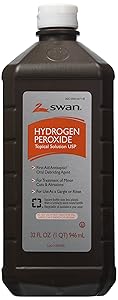 | Hydrogen Peroxide |
| Check on Amazon → |
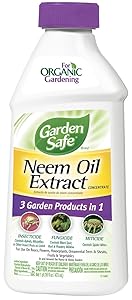 | Neem Oil |
| Check on Amazon → |
 | AzaMax |
| Check on Amazon → |
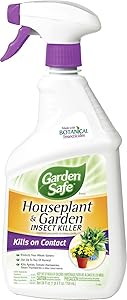 | Garden Safe Houseplant & Garden Insect Killer |
| Check on Amazon → |
Environmental Products To Wipe Out Fungus Gnat Larvae:
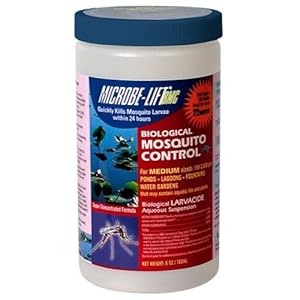 | Microbe-Lift BMC Fertilizer |
| Check on Amazon → |
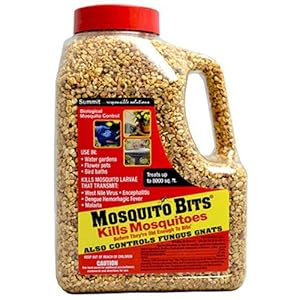 | Mosquito Bits |
| Check on Amazon → |
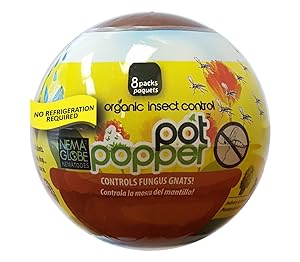 | Nema-Globe Pot Poppers |
| Check on Amazon → |
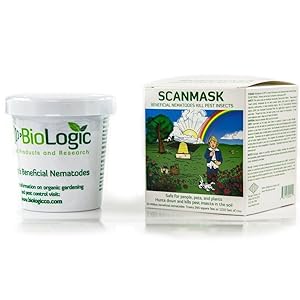 | Dr. Pye's Scanmask Beneficial Nematodes |
| Check on Amazon → |
Products For Fungus Gnat Prevention:
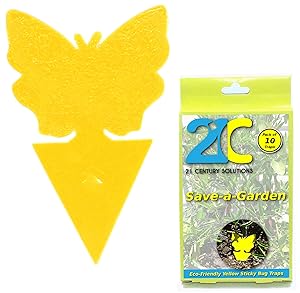 | 21C Butterfly-Shaped Yellow Sticky Stakes |
| Check on Amazon → |
 | TraPro Yellow Sticky Traps |
| Check on Amazon → |
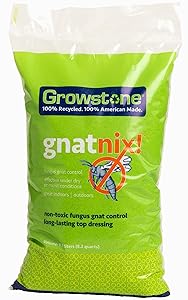 | Growstone GnatNix Fungus Gnat Control Mulch |
| Check on Amazon → |
Fungus Gnat Overview

| Common Name(s) | Fungus gnats |
| Scientific Name(s) | Multiple, but the dangerous ones to plants are Sciaridae family spp. |
| Family | Sciaridae |
| Origin | Worldwide |
| Plants Affected | Indoor/nursery/greenhouse plants, some outdoor plants. Particularly susceptible are plants such as carnations, African violets, geraniums, and poinsettias, but they can strike any weakened plant in the right conditions. |
| Common Remedies | Hydrogen peroxide soil drenches, neem oil, other azadirachtins, pyrethrins, beneficial nematodes, Bacillus thurigiensis var. israelensis, sticky stakes/sticky traps, and mulches |
Types of Fungus Gnat Larvae
There are six different families of insects which make up the broader category of fungus gnats. These six families include the Sciaridae, Mycetophilidae, Ditomyiidae, Bolitophilidae, Diadocidiidae, and Keroplatidae.
Most fungus gnat species are not harmful to our gardens, but the dangerous ones are in the Sciaridae family.
While adults don't cause any lasting damage, the fungus gnat larvae of that family will move on to plant roots once their preferred foodstuff is gone. The larvae will chew holes in the roots and can cause yellowing, wilting, and even plant death in large numbers.
Not only do they damage roots, but the Sciaridae can spread disease. Since their preferred food is fungal growth, they can easily pick up spores from infected plants or soil and spread leaf spots, scabs, cankers, rot, and more.
Fungus gnat adults are often confused with mosquitos as they look similar in shape, but are much smaller. These tiny black gnats rarely get any larger than an eighth of an inch long.
The larvae themselves grow a bit larger than the adult gnats. Fungus gnat larvae have a black, shiny head with a white to clear body that can reach almost a quarter inch in length. They're hard to locate because they tend to remain under the soil's surface, out of view.
Life Cycle Of Fungus Gnats

The life cycle of the fungus gnat is made up of four stages: egg, larvae, pupae, and adult.
The adult fungus gnat can lay about three hundred eggs in its short lifespan. They typically only live for about a week as adults, so they make the most of their time! Eggs are laid in rich and fertile, moist soil at the base of plants.
About four to six days after the eggs are laid, the larvae emerge. These larvae will be extremely tiny at first. During the roughly two-week period in which fungus gnat larvae are growing, they rapidly increase in size by eating their way through organic matter in the soil.
Once they've achieved maximum larval growth, there will be a 3-4 day pupal phase. The pupae will be hidden under the soil's surface, and when the adult emerges, this cycle begins again.
Because of this quick life cycle, many generations of fungus gnat can be born in quick succession. In addition, many stages of the life cycle may be present at any given time. Not only do you need to get rid of the annoying gnats themselves, but you'll need to deal with the larvae and find a way to sterilize the eggs.
Common Habitats For Fungus Gnat Larvae
Moist and rich soil, especially soil that tends to be a bit overly-damp, is perfect for fungus gnat larval development. Planting mixes that contain a heavy amount of peat moss or coconut coir will encourage them to move in and take up residence.
Avoid overwatering, especially during the cooler winter and spring months. Too much moisture will speed their development as it can cause roots to begin to decay, making a perfect food source.
Greenhouses stay warmer through the winter months than the outside garden, which makes them a perfect place for fungus gnats to try to overwinter. It's especially risky as they typically have richer soils that are regularly watered, making for prime fungus gnat real estate.
In addition, people who have houseplants may find fungus gnats trying to invade their homes during the winter. Needless to say, that's something that you absolutely want to stop as soon as possible!
What Do Fungus Gnat Larvae Eat?

While most fungus gnat larvae prefer decaying organic materials and fungal growths, any weakness or rot in plant roots can make them appealing targets. Similarly, if there's a lack of organic material in the soil, the gnat larvae will feast on your plants instead.
Especially at risk to fungus gnat larvae are African violets, geraniums, poinsettias, and carnations. These four plants not only can develop root rot quickly, but they tend to live in a nearly-ideal soil type for the gnat larvae to colonize.
However, nearly any plant that is weak can succumb to fungus gnat larvae. Keeping your plants strong and healthy and free of decay will help protect them from this pest.
When Fungus Gnats Strike

You're most likely to get fungus gnat problems around the fall. As the weather cools, they seek out warmer temperatures, and your house or greenhouse are prime locations. Once they get to your soil and start laying eggs, they can damage or destroy your plants rapidly.
If you have plant problems and suspect it might be the work of fungus gnats, be on the lookout for yellow leaves that otherwise appear normal, or extremely slow growth. Both are symptoms of fungus gnat larvae in the soil.
If you spot either of these symptoms, or see adult flies buzzing around your garden, you need to react immediately.
Treat all your plants, not just the ones closest to the flies! It's very hard to know if larvae are on plants that look alright, so you should cover your bases and treat everything. It's better to be safe than sorry.
Plants recovering from fungus gnat problems still face the risk of disease problems. Fungus gnat larvae can spread fungus spores that are dropped by adult gnats to your plant's roots, possibly causing a number of common plant diseases.
As a precaution, treat any affected plants and those in the area with fungicide a day or two after pesticide application. This ensures that if your plants did have contact with potentially dangerous disease spores, they shouldn't contract the disease.
A root drench is more effective than spraying the plant's foliage, as that's where damage would be done.
How To Get Rid Of Fungus Gnat Larvae

If you use the prevention methods below, you may never see fungus gnats or their larvae. But if you do, here's how to wipe them out!
Organic Fungus Gnat Control
Interestingly enough, a common household item is one of the top recommendations that I have for controlling these pests. Hydrogen peroxide (the standard 3% topical variety) can be used as a soil drench.
Mix one part peroxide with four parts water, and pour it through the soil at the root zone until it begins to come out of the base of the pot. The peroxide kills fungus gnat larvae on contact.
Neem oil is also an effective soil drench to combat fungus gnat larvae. Dilute the oil with water per manufacturer's directions and directly drench the soil at the roots of the plant. You can also spray the upper portion of the plant to keep adult gnats at bay.
AzaMax is a higher-strength concentration of the azadirachtin which naturally occurs in neem oil. It's safe in hydroponics use as well as in greenhouses, gardens, and indoors. Use it per manufacturer's directions in the same way you would use neem oil.
Pyrethrin sprays are also effective against fungus gnats and their larvae. I recommend Garden Safe Houseplant & Garden Insect Killer.
To use pyrethrins, lightly mist all plant surfaces and the top of the soil. You don't want the plants dripping wet, a thin mist will be enough.
If there's fungus gnat larvae in the soil, spray the soil directly to thoroughly moisten the top, then avoid watering until the soil has dried to at least a 2″ depth.
Environmental Fungus Gnat Control
One particular form of bacteria will destroy fungus gnat larvae. Bacillus thurigiensis var. israelensis. It's not in most commercial BT sprays, but it is available as part of a product called Microbe-Lift BMC Fertilizer.
Use this to fertilize with, and you should see a decline in your fungus gnat problems.
Another way to get this bacteria in your soil is by sprinkling Mosquito Bits over the surface and watering them in. You can use these both indoors and outdoors. They aren't just for mosquito killing!
As they break down, they release Bacillus thurigiensis var. israelensis into your soil, where it can get to work killing larvae.
Beneficial nematodes can also play a major part in eradicating the fungus gnat larvae. You won't be able to see these microscopic soil-dwellers, but they will take out the fungus gnat larvae along with hundreds of other soil-dwelling pests.
For people with indoor plants, you can add these nematodes to your soil with one of these Nema-Globe Pot Poppers. Larger garden or full yard coverage can be achieved using Dr. Pye's Scanmask, which disperses the nematodes evenly with water.
Be aware that you cannot use beneficial nematodes at the same time as your hydrogen peroxide soil drench, as it will kill the nematodes! Wait for at least a couple weeks after the infestation and then add nematodes back into the soil.
Preventing Fungus Gnats
Inspect potential plants before buying them. Check at the base of the plant, gently looking through the soil to find signs of the clear or whitish fungus gnat larvae. Avoid any plants with visible adults around them.
To be doubly sure that new plants are pest-free, keep them quarantined from other plants for at least 2-3 weeks. This gives you plenty of time to spot newly-emerged adults, as well as establish control methods before they can spread.
Avoid overwatering your plants. Also, if fungus gnats or their larvae are in evidence, avoid watering until the soil has dried to at least 2″ deep.
Be sure to use sticky traps to find adult gnats. Since it only takes one gnat to lay potentially hundreds of eggs, you want to keep the adults at bay!
For indoor plants, these butterfly-shaped sticky stakes work well and are smaller in size (although they'll still look big next to smaller plants). Outdoors, you can use these double-sided sticky traps.
Finally, mulching has good effect against fungus gnat infestation, as the mulch keeps the adults away from the soil. This prevents them from laying their eggs.
You can use a thick layer of a stone chip mulch over your soil, or opt for a product such as GnatNix.
Made from recycled glass, GnatNix prevents emerging adults from getting out of the soil. It also keeps adult fungus gnats from laying their eggs in the first place.
In the end, the best solution for fungus gnats is prevention. But there are many options you can take if they catch you unexpectedly. Have you ever fought against fungus gnat larvae or adults? What methods did you choose? Share your stories with us in the comments below!
The Green Thumbs Behind This Article:
How To Kill Indoor Garden Fungus Gnats
Source: https://www.epicgardening.com/fungus-gnats/#:~:text=Organic%20Fungus%20Gnat%20Control,-Interestingly%20enough%2C%20a&text=Mix%20one%20part%20peroxide%20with,to%20combat%20fungus%20gnat%20larvae.
Posted by: vaughtthastenthe.blogspot.com

0 Response to "How To Kill Indoor Garden Fungus Gnats"
Post a Comment